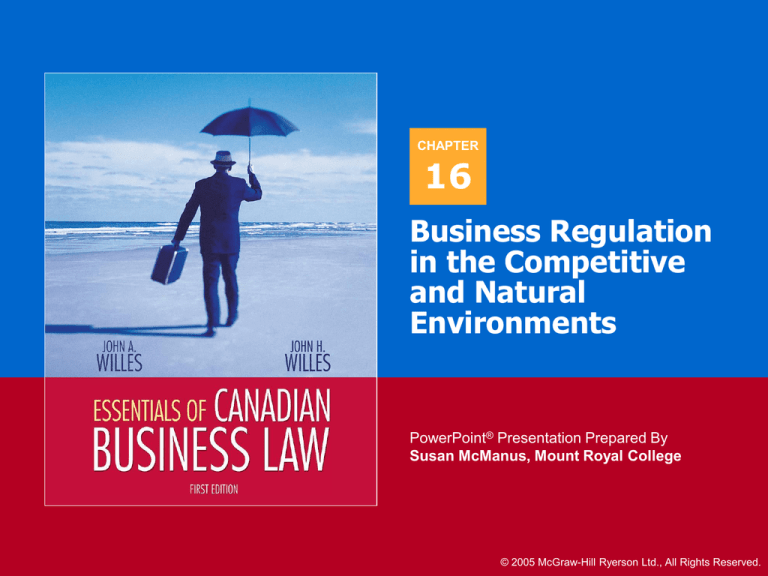
CHAPTER
16
Business Regulation
in the Competitive
and Natural
Environments
PowerPoint® Presentation Prepared By
Susan McManus, Mount Royal College
© 2005 McGraw-Hill Ryerson Ltd., All Rights Reserved.
CH 16
LEARNING OBJECTIVES
Examine government regulation of a competitive
business environment
Consider the legal responsibility of business
operations toward our natural environment
Essentials of Canadian Business Law, 1st Canadian Edition
Slide 16-1
© 2005 McGraw-Hill Ryerson Ltd., All Rights Reserved.
16.1
Introduction
Government control over business
Federal legislation
Competition legislation prohibiting unfair business
practices
Governs interprovincial activities
Governs areas such as safety standards for products
(food, medicines, tires) and control of hazardous
products
Provincial legislation
All business activities not within federal exclusive
jurisdiction
Governs areas such as sale of goods, business
organizations, employment and professions
Essentials of Canadian Business Law, 1st Canadian Edition
Slide 16-2
© 2005 McGraw-Hill Ryerson Ltd., All Rights Reserved.
16.2
Competition Law
Purpose of competition law
Preservation and protection of competition by
restriction on activities that tend to interfere with
competition
Anticompetitive behaviour
“Restrictive trade practices” – restricting the
freedom of buyers and sellers
Abuse of a dominant position – eliminating
consumer choice
Conspiracy with others to restrain trade
Misleading advertising and promotion
Essentials of Canadian Business Law, 1st Canadian Edition
Slide 16-3
© 2005 McGraw-Hill Ryerson Ltd., All Rights Reserved.
16.2
Competition Law (Cont’d)
Competition Act
Attempts to limit forces interfering with free
competition (undue interference with free
enterprise)
Makes unfair trade practices criminal offences,
applicable to the Crown and private sector
Essentials of Canadian Business Law, 1st Canadian Edition
Slide 16-4
© 2005 McGraw-Hill Ryerson Ltd., All Rights Reserved.
Figure 3-1
Procedure Where
the Complaint
Concerns a
Reviewable Trade
Practice
Essentials of Canadian Business Law, 1st Canadian Edition
Slide 1-5
© 2005 McGraw-Hill Ryerson Ltd., All Rights Reserved.
16.3
Nature of the Legislation
Competition Act
Blend of criminal and administrative approaches to
the regulation of restraint of trade, including civil
remedies to those injured by violations of the Act
Investigative powers, including wide powers of
search and seizure and the right to question
corporate officers, given to the Commissioner of
Competition
Essentials of Canadian Business Law, 1st Canadian Edition
Slide 16-6
© 2005 McGraw-Hill Ryerson Ltd., All Rights Reserved.
16.3
Nature of the Legislation (Cont’d)
Competition Act
Offences are subject to the criminal law standard
of proof – beyond a reasonable doubt
Competition Tribunal
A unique tribunal with lay members and judges of the
Federal Court – Trial Division
Hears
Reviewable practices cases such as exclusive dealing
(contract to carry only the manufacturer’s product)
Matters dealing with foreign issues
Specialized agreements and mergers
Essentials of Canadian Business Law, 1st Canadian Edition
Slide 16-7
© 2005 McGraw-Hill Ryerson Ltd., All Rights Reserved.
16.4
Restrictive Trade Practices
Competition Act
Applies to both goods and services
Three categories of restrictive trades practices
Related to the nature of the business firm itself
(dominant positioning)
Arising out of dealings between a firm and its
competitors
Arising out of dealings between a firm and its
customers
Essentials of Canadian Business Law, 1st Canadian Edition
Slide 16-8
© 2005 McGraw-Hill Ryerson Ltd., All Rights Reserved.
16.5
Mergers and Dominant Firms
Firms become dominant in a field or
industry by
Gradual elimination of competition
Mergers to assume a dominant position
Competition Tribunal will review and intervene
when the merger or monopoly reduces competition
to the detriment of the public
May prohibit or modify the proposed change
Essentials of Canadian Business Law, 1st Canadian Edition
Slide 16-9
© 2005 McGraw-Hill Ryerson Ltd., All Rights Reserved.
16.6
Dealings Between Competitors
Legislation prohibits conspiracies and
combinations that “unduly” lessen
competition
Difficult to prove
Normally applies only to domestic situations and
includes
Banks, services (professional sports) and bid rigging
(secret arrangements on bids)
Exemptions: activities wholly related to exports,
standards of competency in services, and affiliated
corporations
Essentials of Canadian Business Law, 1st Canadian Edition
Slide 16-10
© 2005 McGraw-Hill Ryerson Ltd., All Rights Reserved.
16.7
Dealings with Customers
Offences relating to distribution - special
concessions that would lessen or destroy
competition
Lower prices and special allowances
Lower prices in geographical areas
Controlling resale prices
Seller may refuse to sell goods if the buyer was
selling goods as a loss leader (less than cost and
not for profit)
What examples are prevalent of these offences?
Essentials of Canadian Business Law, 1st Canadian Edition
Slide 16-11
© 2005 McGraw-Hill Ryerson Ltd., All Rights Reserved.
16.8
Reviewable Activities
Competition Tribunal may review different selling
methods that result in competition being
substantially lessened
Methods include: abuse of dominant position, refusal
to supply goods, consignment selling, exclusive
dealing, “tied” selling, and market restriction
May also review foreign directives and arrangements
in restraint of trade
Essentials of Canadian Business Law, 1st Canadian Edition
Slide 16-12
© 2005 McGraw-Hill Ryerson Ltd., All Rights Reserved.
16.9
Offences Relating to Promotion
and Advertising of Products
Competition Act
Offence arising from any material representation to
the public that is false or misleading about
products or prices
Provides a criminal and civil approach
Essentials of Canadian Business Law, 1st Canadian Edition
Slide 16-13
© 2005 McGraw-Hill Ryerson Ltd., All Rights Reserved.
16.9
Offences Relating to Promotion
and Advertising of Products (Cont’d)
Offences include
Sales above the advertised price – allowance is
made for prompt action to correct an error
Double ticketing – goods must be sold at the
lowest marked price
“Bait and switch” – advertising goods at a low price
to attract customers and having no adequate
supply; defences by the seller:
tried to obtain enough product
did not anticipate the heavy demand
“rain checks” given
Essentials of Canadian Business Law, 1st Canadian Edition
Slide 16-14
© 2005 McGraw-Hill Ryerson Ltd., All Rights Reserved.
16.10
Civil Actions under the Competition Act
Common law civil actions
For activities not covered by legislation
For actions in breach of the Competition Act or
Competition Tribunal (conviction could be used as
evidence by the plaintiff)
Plaintiff may claim damage for actual loss
Burden of proof by the plaintiff is based on the
balance of probabilities (civil law burden not
criminal law)
Essentials of Canadian Business Law, 1st Canadian Edition
Slide 16-15
© 2005 McGraw-Hill Ryerson Ltd., All Rights Reserved.
16.12
Environmental Law: The Common Law
Courts at common law consider
environmental injuries on an individual
basis, rather than public
Tort of nuisance is used where the actions of one
individual interfere with the property or rights of
another
Claims for damages only and do not extend to
clean-up or elimination of the sources of pollutants
Essentials of Canadian Business Law, 1st Canadian Edition
Slide 16-16
© 2005 McGraw-Hill Ryerson Ltd., All Rights Reserved.
16.13
Environmental Legislation
Legislation
Provides protection for the environment by
prohibiting activities that have a negative impact
on the environment
Jurisdiction is both federal and provincial, with
some overlap
Essentials of Canadian Business Law, 1st Canadian Edition
Slide 16-17
© 2005 McGraw-Hill Ryerson Ltd., All Rights Reserved.
16.13
Environmental Legislation (Cont’d)
Very high standard of care is imposed
Director and officers
May be personally liable for pollution unless they can
prove “due diligence”
“Due diligence” requires proof of actual control and
responsibility, not simple delegation to management
Areas of control
Harmful substances into air, water & ground
Storage and transportation of hazardous products
Requirement of environmental assessments
Enforcement by inspection and monitoring
Fines, clean-up costs, licensing and approval may be
required
Essentials of Canadian Business Law, 1st Canadian Edition
Slide 16-18
© 2005 McGraw-Hill Ryerson Ltd., All Rights Reserved.
16.14
Environmental Responsibility
Environmental damage
Responsibility of the party causing the damage
and the current owner of the property
Order to clean-up may exceed the value of the
property
“Clean” environmental audit should be a
precondition to land purchase and financing
Discuss the major environmental concerns for
businesses?
Essentials of Canadian Business Law, 1st Canadian Edition
Slide 16-19
© 2005 McGraw-Hill Ryerson Ltd., All Rights Reserved.
CH 16
SUMMARY
Competition Act
Preservation and protection of competition by
control of activities
Anticompetitive behaviours – “restrictive trade
practices”; abuse of dominant position; conspiracies
and combinations; and misleading advertisement and
promotion
Competition Tribunal established to review practices
and enforce the Act
Criminal, administrative, and civil law approaches
under the Act
Essentials of Canadian Business Law, 1st Canadian Edition
Slide 16-20
© 2005 McGraw-Hill Ryerson Ltd., All Rights Reserved.
CH 16
SUMMARY (Cont’d)
Environmental Law
Common law – Tort of Nuisance
Limited to injuries of individuals on a personal level
Environmental legislation
Federal and provincial jurisdiction
Prohibits activities that damage the environment
Inspection and monitoring for compliance
Personal liability by directors and officers
Environmental Responsibility
By parties causing the damage and owners of the property
Reduce by a “clean” environmental audit for purchase or
finance of land
Essentials of Canadian Business Law, 1st Canadian Edition
Slide 16-21
© 2005 McGraw-Hill Ryerson Ltd., All Rights Reserved.







